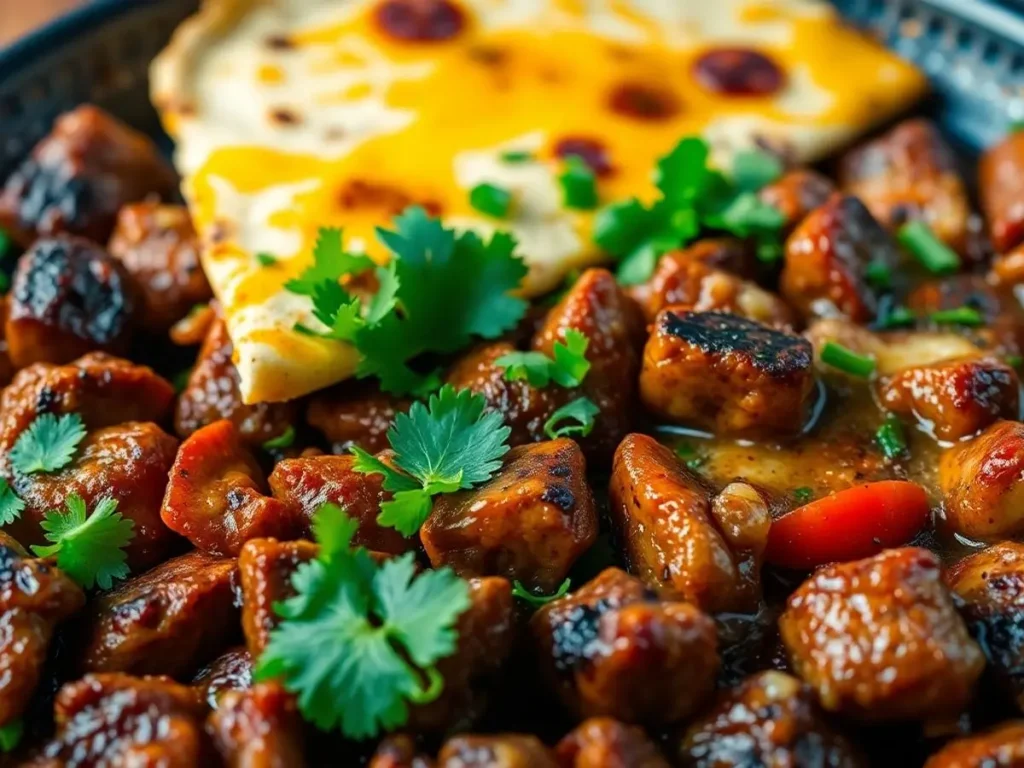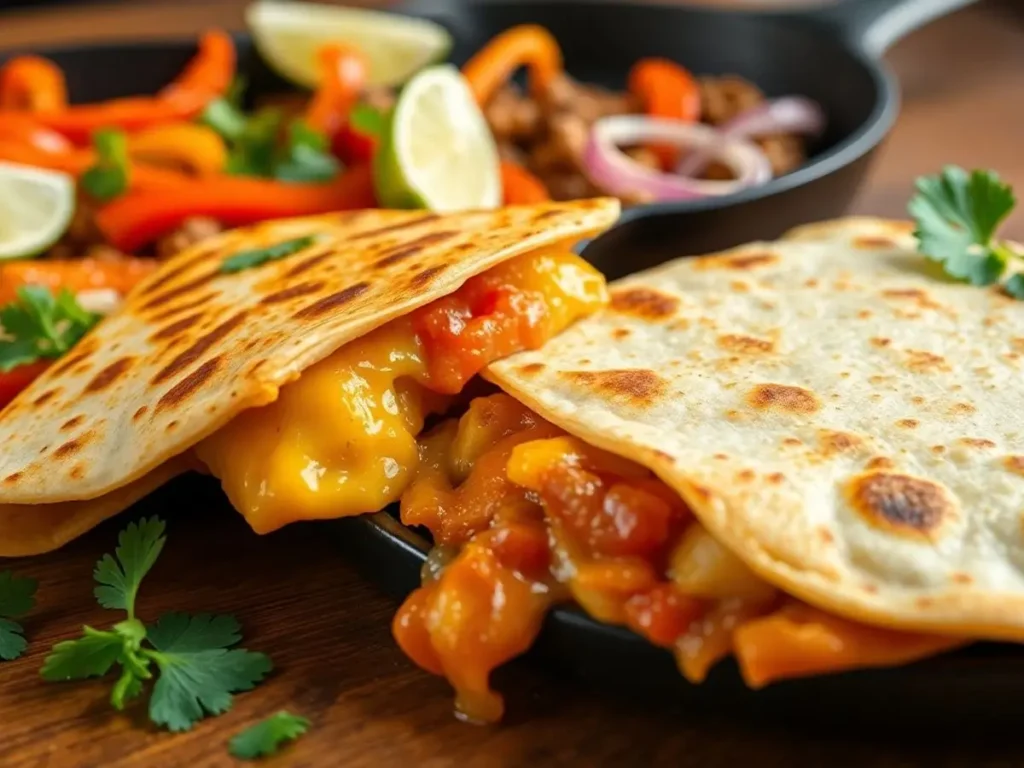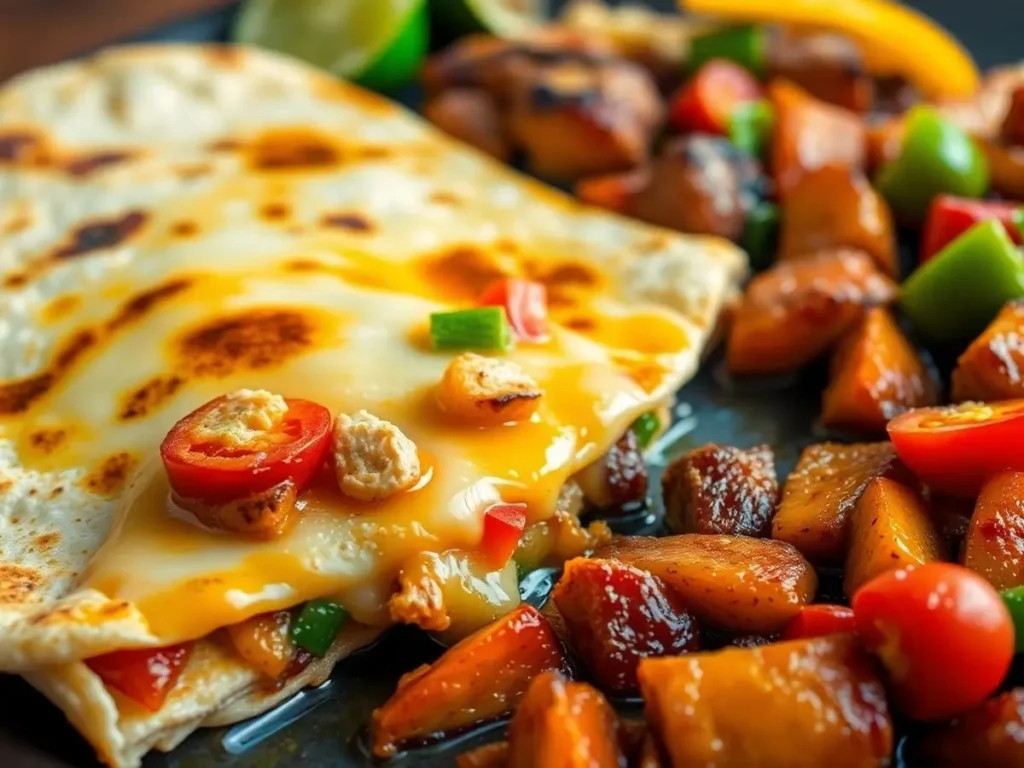What the difference between quesadillas and fajitas? They’re both tasty, sure, but they bring their own flair to the table. Quesadillas are all about that cheesy goodness, while fajitas are sizzling with vibrant veggies and seasoned meat. They’re staples in Mexican cuisine, each with its own cooking style and taste. Let’s break down what sets them apart and why you might crave one over the other.
Table of contents
Key Takeaways
- Quesadillas are primarily cheese-filled tortillas, often with other fillings like meat or veggies.
- Fajitas feature grilled meat and vegetables, typically served with tortillas on the side.
- Cooking techniques differ: quesadillas are usually pan-cooked to melt the cheese, while fajitas involve grilling or sautéing.
- Both dishes offer unique flavor profiles, with quesadillas focusing on cheesy richness and fajitas on spicy, savory notes.
- Serving styles vary, with quesadillas often being a quick snack or meal, while fajitas are a more interactive dining experience.
Understanding the Basics of Quesadillas and Fajitas
Defining Quesadillas
Quesadillas are like the Swiss army knife of meals—quick, versatile, and super customizable. Think of them as a tortilla sandwich with the gooey goodness of cheese at the center. Typically, they feature melty cheeses like mozzarella or cheddar, paired with fillings such as seasoned chicken, vegetables, or beans. For those who like to experiment, fresh garnishes, spices, and unique ingredients can elevate the dish. Whether you keep it traditional or go wild with creativity, quesadillas are a satisfying option for any meal.
Defining Fajitas
Fajitas, on the other hand, are all about the sizzle. Originally, they were made with skirt steak, but now you can find them with chicken, shrimp, or even tofu. The key is in the preparation: marinated meat, seared to perfection, served with sautéed onions and peppers. Wrap it all up in a soft tortilla, and you’ve got a dish that’s both hearty and flavorful. The essence of fajitas lies in their simplicity and bold flavors.
Key Ingredients in Quesadillas and Fajitas
When it comes to ingredients, both dishes have their stars. For quesadillas, it’s all about the cheese and tortillas, but don’t forget the extras like beans, meats, and veggies. Fajitas focus on the protein and those iconic sautéed veggies. Here’s a quick breakdown:
- Quesadillas: Cheese, tortillas, chicken, beans, vegetables
- Fajitas: Skirt steak or chicken, bell peppers, onions, tortillas
Quesadillas and fajitas share some common elements, yet each brings its own unique flair to the table. Whether you’re in the mood for something cheesy or something sizzling, both dishes promise a delightful culinary experience.
Cooking Techniques for Quesadillas and Fajitas

Grilling vs. Pan Cooking
When it comes to cooking quesadillas and fajitas, the method you choose can really change the outcome. Grilling adds a smoky flavor that’s hard to beat, especially for fajitas. For quesadillas, pan cooking is often preferred because it allows for even heat distribution, ensuring the cheese melts perfectly.
- Grilling:
- Pan Cooking:
Cheese Melting Techniques
The art of melting cheese in a quesadilla is all about timing and temperature. Use a low to medium heat to avoid burning the tortilla while allowing the cheese to melt completely. Covering the pan can help trap the heat and melt the cheese faster without overcooking the tortilla.
Sautéing Vegetables for Fajitas
Sautéing vegetables is key to a good fajita. Use a hot pan and a bit of oil to get a nice char on the veggies. Timing is everything here; usually, 5-10 minutes is enough to get them just right. Add the seasoning towards the end to keep the flavors fresh and vibrant.
The right cooking technique can make or break your quesadillas and fajitas. It’s all about finding that perfect balance between heat and time, ensuring every bite is as tasty as the last.
Flavor Profiles of Quesadillas and Fajitas

Spices Used in Quesadillas
Quesadillas are often all about the fillings, and the spices can make or break the dish. Typically, Mexican quesadillas might feature a hint of cumin or chili powder, while American versions could lean into garlic powder or paprika. The choice of spice depends heavily on the other ingredients in the quesadilla. A classic cheese quesadilla might keep it simple, letting the cheese shine, but add some chicken or beef, and you’ll want a spice blend that complements without overpowering.
- Traditional spices: cumin, chili powder
- American twists: garlic powder, paprika
- Balance: complement the main filling
Marinades for Fajitas
Fajitas, on the other hand, are all about the marinade. The flavor really comes from how the meat soaks up the spices and sauces before cooking. A good fajita marinade might include lime juice, garlic, and a pinch of cayenne for heat. It’s all about getting that meat tender and packed with flavor. Whether you’re using beef, chicken, or even shrimp, the marinade sets the stage for a tasty meal.
- Key ingredients: lime juice, garlic, cayenne
- Meat options: beef, chicken, shrimp
- Marinade time: at least 30 minutes for best results
Balancing Flavors in Both Dishes
Balancing flavors in quesadillas and fajitas is like a dance. You want the right mix of spicy, savory, and sometimes even a bit of sweet. For quesadillas, the cheese is usually the star, so every other flavor should play a supporting role. With fajitas, the meat and veggies need to harmonize, with the sauce tying everything together.
Quesadillas and fajitas each offer a unique flavor experience, but both require careful attention to spice and balance to truly shine.
When crafting these dishes, remember:
- Let the main ingredient lead.
- Use spices to enhance, not overshadow.
- A little sauce goes a long way in bringing everything together.
Serving Styles of Quesadillas and Fajitas
Traditional Serving Methods
Traditionally, quesadillas and fajitas have their own unique serving styles that highlight their flavors. Quesadillas are usually sliced into wedges, making them easy to share. They’re often served with a side of salsa, which adds a fresh and spicy kick. Fajitas, on the other hand, are typically presented on a sizzling platter, accompanied by warm tortillas so you can build your own wraps. This interactive style makes fajitas a fun meal at any gathering.
Modern Twists on Quesadillas and Fajitas
In recent times, chefs have been experimenting more than ever with these classic dishes, adding modern twists to their presentation. For instance, quesadillas are now often served open-faced, topped with a variety of creative ingredients such as avocado, shrimp, or even unique types of cheese. Similarly, fajitas have undergone innovations, with lighter options like lettuce wraps replacing traditional tortillas. As a result, these modern adaptations not only keep the dishes exciting but also make them more versatile, appealing to a wider range of taste preferences and dietary needs..
Pairing Sides and Beverages
Pairing the right sides and drinks can elevate the experience of enjoying quesadillas and fajitas. Consider serving quesadillas with a side of guacamole or a fresh salad to balance the richness of the cheese. For fajitas, rice and beans are classic accompaniments. As for drinks, a cold beer or a margarita can perfectly complement the meal. Whether you’re enjoying these dishes at home or at a restaurant, the right pairings can make all the difference.
Embracing both tradition and innovation, quesadillas and fajitas offer a versatile dining experience that caters to all tastes and occasions. From classic presentations to contemporary twists, these dishes continue to delight and satisfy.
Cultural Significance of Quesadillas and Fajitas

Origins of Quesadillas
Quesadillas have been a staple in Mexican cuisine for centuries. Originally, they were simple corn tortillas filled with cheese, cooked on a griddle. Over time, various regions in Mexico have put their spin on this dish, adding ingredients like mushrooms, squash blossoms, and even huitlacoche, a type of corn fungus. In many Mexican households, quesadillas are more than just a meal; they are a tradition passed down through generations. They are often enjoyed during family gatherings and celebrations, symbolizing unity and shared heritage.
History of Fajitas
Fajitas, on the other hand, have a more recent history, with roots in Tex-Mex cuisine. The term “fajita” originally referred to the cut of beef used in the dish, specifically skirt steak. Ranch workers in Texas made the most of this less desirable cut by marinating it and grilling it over an open flame. The dish became popular in the 1970s and has since evolved to include various proteins like chicken and shrimp. Fajitas are now a fixture in many Mexican restaurants, offering a sizzling spectacle that delights diners.
Regional Variations Across Mexico
Both quesadillas and fajitas showcase the diverse culinary landscape of Mexico. Regional variations abound, with each area adding its unique touch. In Mexico City, quesadillas might include ingredients like quesadilla rellena, which features two tortillas stuffed with cheese and various fillings, cooked until crispy. Meanwhile, in northern Mexico, fajitas might be served with flour tortillas and a variety of grilled vegetables. These regional differences highlight the rich tapestry of Mexican cuisine and the creativity that goes into each dish.
Quesadillas and fajitas are not just food; they are a celebration of Mexican culture and its ability to adapt and thrive across borders. The flavors, the history, and the communal aspect of sharing these dishes make them beloved by many.
In essence, whether you’re savoring a traditional quesadilla or enjoying a modern take on fajitas, you’re partaking in a culinary journey that bridges history and innovation. Both dishes tell a story of resourcefulness, tradition, and a deep appreciation for flavor. They remind us that food is not just about sustenance but also about connection and culture.
Nutritional Differences Between Quesadillas and Fajitas
Caloric Content Comparison
When you’re thinking about calories, quesadillas and fajitas have their own stories to tell. Quesadillas, often loaded with cheese and sometimes meats, can pack a calorie punch. Fajitas, on the other hand, usually feature grilled meats and veggies, making them a lighter option. Here’s a quick look at the average calorie count:
| Dish | Calories (per serving) |
|---|---|
| Quesadilla | 500-700 |
| Fajitas | 300-500 |
Protein and Carb Breakdown
Both dishes offer a decent amount of protein, but the source can vary. Quesadillas typically get their protein from cheese and meat, while fajitas rely on grilled meats like chicken or beef. Carbs in quesadillas mainly come from the tortillas, whereas fajitas have fewer carbs since they’re often served with more vegetables.
- Quesadillas:
- Fajitas:
Healthier Alternatives
If you’re looking to enjoy these dishes without the guilt, there are healthier options available. Consider these tweaks:
- Swap regular tortillas for whole wheat or low-carb versions.
- Use less cheese in quesadillas or opt for a low-fat variety.
- Load up on veggies in fajitas to boost fiber and nutrients.
Balancing taste and nutrition is key. With a few adjustments, you can enjoy these flavorful dishes while keeping your health in check.
For a delicious twist, try making shrimp fajita quesadillas with seasoned shrimp, sautéed peppers, and onions. It’s a lighter, yet satisfying option that’s perfect for any meal.
Popular Quesadilla and Fajita Recipes
Classic Cheese Quesadilla Recipe
Making a classic cheese quesadilla is super easy and quick. You just need some flour tortillas, cheese, and maybe a few extras if you feel fancy.
- Warm the tortillas: Place a flour tortilla on a hot skillet.
- Add cheese: Sprinkle your favorite cheese, like cheddar or Monterey Jack.
- Cook: Fold the tortilla in half and cook until the cheese melts.
- Serve: Cut into wedges and enjoy with salsa or sour cream.
Chicken Fajita Recipe
Chicken fajitas are a favorite Mexican dish that combines juicy chicken with vibrant vegetables. Here’s how you can whip it up:
- Prepare the chicken: Slice the chicken into strips and marinate with spices.
- Cook the veggies: Sauté onions and bell peppers until soft.
- Combine: Add the marinated chicken to the pan and cook thoroughly.
- Serve: Wrap the mix in warm flour tortillas.
Vegetarian Options for Both Dishes
For those who prefer a meatless meal, vegetarian quesadillas and fajitas are a tasty alternative.
- Quesadillas: Use corn tortillas filled with cheese, beans, and sautéed vegetables.
- Fajitas: Substitute chicken with mushrooms or zucchini, and add plenty of colorful veggies.
- Extras: Consider adding refried beans or guacamole for extra flavor.
Whether you’re craving a simple cheese quesadilla or a flavorful chicken fajita, these recipes bring the taste of Mexico right to your kitchen. Experiment with different fillings and enjoy a variety of delicious combinations.
Wrapping It Up
So there you have it, the lowdown on quesadillas and fajitas. Both are tasty, no doubt, but they bring different vibes to the table. Quesadillas are all about that cheesy goodness, wrapped up and ready to go. Fajitas, on the other hand, are more of a DIY affair, letting you pile on the toppings just how you like. Whether you’re in the mood for something quick and cheesy or a meal where you can play with flavors, both have their own charm. Next time you’re at a Mexican restaurant or cooking at home, you’ll know exactly what you’re in for. Enjoy your meal!
Frequently Asked Questions
What’s the difference between a fajita and a tortilla?
A tortilla is a flatbread made from flour or corn, used as a base for many dishes. A fajita refers to a specific dish made with grilled meat, onions, and peppers, typically served with tortillas for wrapping. In short, tortillas are an ingredient, while fajitas are a prepared dish.
Which is healthier, fajitas or quesadillas?
Fajitas are often healthier because they are loaded with grilled vegetables and lean protein, like chicken or steak, without much added fat. Quesadillas, on the other hand, are made with a lot of cheese and sometimes fried, which increases the calorie and fat content. Opting for lighter toppings and whole-grain tortillas can make both dishes healthier
What makes it a fajita?
Although cheese is not a traditional topping for fajitas, many people enjoy adding it for extra flavor. For instance, shredded cheddar, Monterey Jack, or a Mexican blend are popular options. Ultimately, whether or not to include cheese comes down to personal preference. Traditionally, fajitas highlight the fresh flavors of the meat, vegetables, and toppings like salsa or guacamole, so cheese is purely optional.
